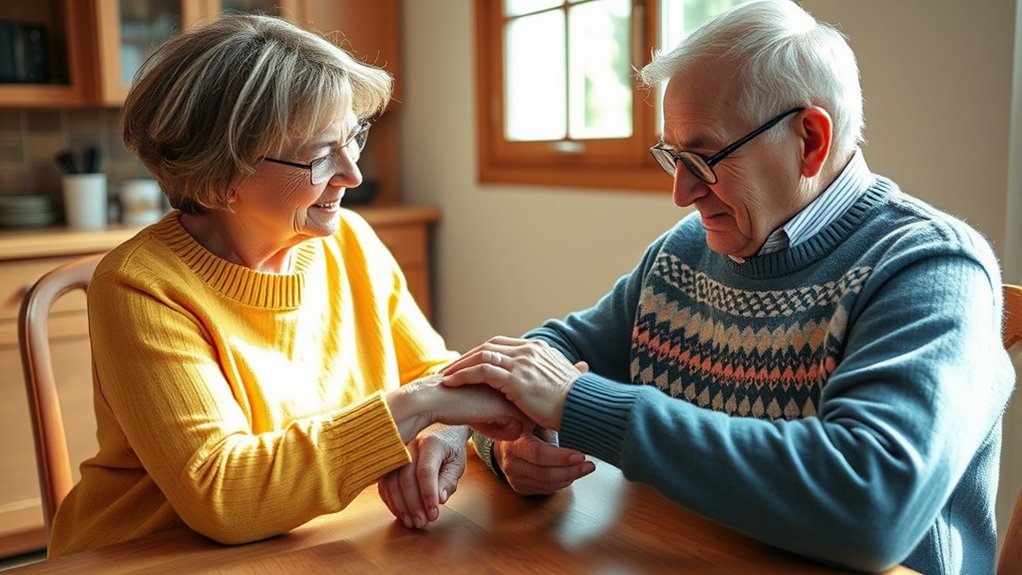To help a loved one regain daily living skills after a stroke, offer emotional support and create a safe space for them to express feelings. Introduce adaptive tools gradually to boost independence and establish structured routines with visual cues. Encourage their efforts, celebrate small victories, and support cognitive and sensory activities to motivate progress. If you keep exploring, you’ll find more ways to assist their recovery journey effectively.
Key Takeaways
- Offer emotional support by listening, encouraging, and celebrating small victories to boost confidence and motivation.
- Use adaptive technology like ergonomic tools and voice assistants to promote independence in daily tasks.
- Establish routines and label environments to create a structured, predictable environment that aids memory and organization.
- Encourage and support effort toward independence while providing assistance to prevent frustration or overwhelm.
- Incorporate cognitive and sensory activities, such as engaging visual tools, to stimulate recovery and motivate participation.

A stroke can considerably disrupt your loved one’s ability to perform everyday tasks, but with patience and support, they can regain many of these skills over time. One of the most crucial ways you can help is by providing emotional support. Recovering from a stroke is not only a physical challenge but also an emotional journey. Your loved one may feel frustrated, anxious, or even depressed as they face setbacks. Offering reassurance, encouragement, and a listening ear creates a safe space for them to express their feelings. Celebrate small victories to boost their confidence and remind them of their progress. Your emotional presence can motivate them to keep trying, making the recovery process less daunting.
In addition to emotional support, integrating adaptive technology into their daily routine can markedly enhance their independence. Adaptive devices are designed to compensate for physical or cognitive impairments, making everyday tasks more manageable. For instance, simple tools like grab bars, ergonomic utensils, or voice-activated assistants can help them regain autonomy in the kitchen, bathroom, or other parts of the home. Technology such as speech-to-text apps or reminder systems can assist with memory and organization issues that often follow a stroke. Introducing these tools gradually and demonstrating how to use them builds confidence and encourages your loved one to take on new challenges. Additionally, understanding the importance of home theatre projectors and their features can help create an engaging environment that motivates cognitive and sensory stimulation during recovery.
Creating a structured environment also plays a key role in their recovery. Establish routines that incorporate adaptive technology and consistent cues to help them regain a sense of normalcy. For example, label drawers and shelves to help with organization, or set up a daily schedule using visual reminders. Be patient as they learn to adapt, understanding that progress may be slow and non-linear. Your role is to facilitate their efforts without rushing or overwhelming them. Encourage independence wherever possible but be ready to step in with assistance when needed.
Frequently Asked Questions
How Can I Motivate My Loved One During Recovery?
To motivate your loved one during recovery, use motivational strategies like setting small, achievable goals to boost confidence. Offer consistent encouragement techniques, such as praising progress and showing patience. Keep a positive attitude and celebrate each milestone, no matter how minor. Your support and understanding can make a huge difference, helping them stay focused and motivated to regain their daily living skills after a stroke.
What Safety Measures Should I Implement at Home?
Think of your home as a safe harbor in stormy seas. You should implement home modifications like grab bars, non-slip rugs, and ramps to prevent falls. Keep emergency preparedness items easily accessible, such as a phone, first aid kit, and emergency contacts. Guarantee pathways are clear, lighting is adequate, and hazards are minimized. These safety measures create a secure environment, giving your loved one confidence to navigate daily life safely.
Are There Specific Therapies That Are Most Effective?
You should explore occupational therapy and speech therapy, as they’re highly effective for stroke recovery. Occupational therapy helps your loved one regain daily living skills like dressing and cooking, while speech therapy improves communication and swallowing. Both therapies are tailored to individual needs, encouraging progress and independence. Consistent sessions and a supportive environment boost their recovery, so work closely with your healthcare team to develop a personalized plan that maximizes results.
How Do I Handle Emotional Changes Post-Stroke?
Think of emotional changes post-stroke like a roller coaster—you can’t control the ride, but you can hold on tight. To handle these shifts, encourage your loved one to practice emotional resilience and coping strategies, like mindfulness, journaling, or talking openly. Be patient and supportive, reminding them that these feelings are normal and temporary. Your empathy helps create a safe space for them to process and regain stability.
When Should I Seek Professional Help or Adjustments?
You should seek professional help or adjustments when you notice persistent challenges or new difficulties in your loved one’s daily activities. Timing considerations are essential; don’t wait too long if progress stalls or emotional and physical issues worsen. A professional assessment can identify specific needs and tailor support plans. If you’re unsure or concerned, it’s always best to consult a healthcare provider promptly to guarantee your loved one receives the appropriate care and interventions.
Conclusion
Supporting your loved one through recovery is like tending a delicate garden—you nurture patience and encouragement to help skills blossom again. Remember, progress may be slow, but every small step counts. Celebrate each achievement, no matter how tiny, and stay positive. Your love and persistence are the sunshine that will help them regain independence. Together, you’ll turn the challenging path into a hopeful journey, proving that even the deepest wounds can begin to heal with care.









